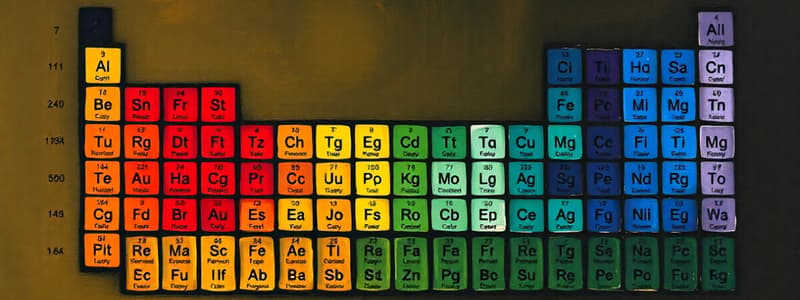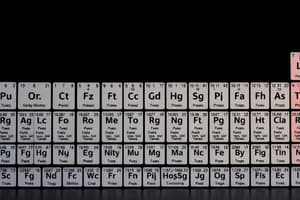Podcast
Questions and Answers
Which of the following elements is both a nonmetal and belongs to the halogen family?
Which of the following elements is both a nonmetal and belongs to the halogen family?
- Radon
- Helium
- Fluorine (correct)
- Barium
Helium, characterized by its low density and inert nature, readily dissolves in water.
Helium, characterized by its low density and inert nature, readily dissolves in water.
False (B)
Define electronegativity in your own words.
Define electronegativity in your own words.
Electronegativity is a measure of an atom's ability to attract shared electrons in a chemical bond.
The alkaline earth metals are located in group number ______ of the periodic table.
The alkaline earth metals are located in group number ______ of the periodic table.
According to Mendeleev's periodic law, how were elements originally arranged in the periodic table?
According to Mendeleev's periodic law, how were elements originally arranged in the periodic table?
Match each element with its correct classification:
Match each element with its correct classification:
Which physical property is characteristic of noble gases?
Which physical property is characteristic of noble gases?
What is one chemical property that is characteristic of noble gasses?
What is one chemical property that is characteristic of noble gasses?
Who is credited with developing the first modern periodic table?
Who is credited with developing the first modern periodic table?
Which of the following elements is NOT a metal?
Which of the following elements is NOT a metal?
Which element is located in Group 4 and Period 6 of the periodic table?
Which element is located in Group 4 and Period 6 of the periodic table?
Which of the following pairings of group number and common name is incorrect?
Which of the following pairings of group number and common name is incorrect?
Elements in the same period have similar chemical properties.
Elements in the same period have similar chemical properties.
Elements that are good conductors of heat and electricity and tend to lose electrons are called ______.
Elements that are good conductors of heat and electricity and tend to lose electrons are called ______.
Flashcards
Mendeleev
Mendeleev
Credited with developing the first modern periodic table.
Metal
Metal
A substance that typically has a shiny appearance, is a good conductor of electricity and heat, and is malleable and ductile.
Hafnium (Hf)
Hafnium (Hf)
Element with symbol Hf, located in Group 4 and Period 6 of the periodic table.
Chromium (Cr)
Chromium (Cr)
Signup and view all the flashcards
Incorrect Group/Name Match
Incorrect Group/Name Match
Signup and view all the flashcards
Incorrect Group/Name Match
Incorrect Group/Name Match
Signup and view all the flashcards
Periodic Law
Periodic Law
Signup and view all the flashcards
Metalloid
Metalloid
Signup and view all the flashcards
Halogens
Halogens
Signup and view all the flashcards
Atomic Mass & Periodic Law
Atomic Mass & Periodic Law
Signup and view all the flashcards
Metal in Group 15
Metal in Group 15
Signup and view all the flashcards
Fluorine (F)
Fluorine (F)
Signup and view all the flashcards
Barium (Ba)
Barium (Ba)
Signup and view all the flashcards
Alkaline Earth Metals
Alkaline Earth Metals
Signup and view all the flashcards
Noble Gases
Noble Gases
Signup and view all the flashcards
Helium (He)
Helium (He)
Signup and view all the flashcards
Electronegativity
Electronegativity
Signup and view all the flashcards
Mendeleev's Periodic Law
Mendeleev's Periodic Law
Signup and view all the flashcards
Study Notes
- Chemistry basics are covered.
- The assignment needs completing after the lesson action section.
- Strategies should be explained when answering questions.
- The mark allocation is at the start of the questions.
- Upon completion, the file should be saved and uploaded.
Introduction to Terminology (Multiple Choice)
- The modern periodic table development is credited to Mendeleev.
- Carbon (C) isn't a metal, unlike Lithium (Li), Aluminum (Al), Magnesium (Mg), and Boron (B).
- Hafnium (Hf) can be found in Group 4 and Period 6 in the periodic table.
- Selenium (Se) is located in Group 6 and Period 4 of the periodic table.
- Group 6 isn't lanthanides.
- Group 2 isn't actinides.
- The periodic law states chemical properties repeat at regular intervals when elements are arranged by increasing atomic number.
- Silicon (Si) is a metalloid in Period 3.
- Bismuth is a metal in Group 15.
- Iodine is a nonmetal in Period 6.
- Halogens are elements in Group 17.
- The periodic law states when elements are arranged by increasing atomic mass, chemical properties repeat at regular intervals.
Putting the Concepts to Work
- Fluorine (F) has an atomic number of 9, belongs to Group 17(helogens), and is a nonmetal in Period 2.
- Barium (Ba) has an atomic number of 56, is in Group 2 (alkaline earth metals), and is a metal in Period 6.
- Helium (He) has an atomic number of 2, is in Group 18 (noble gas), and is a nonmetal in Period 3.
- Alkaline earth metals are in group 2.
- Group 17 family name, is helogens.
- Noble gases in group 18 have low densities and are insoluble in water.
- Electronegativity measures an atom's ability to attract shared electrons.
- Mendeleev arranged the periodic table by increasing atomic mass, properties recur at regular intervals.
Studying That Suits You
Use AI to generate personalized quizzes and flashcards to suit your learning preferences.




